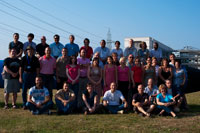Particle physics close up: CERN high-school teachers programme Inspire article
Every year, CERN invites a group of high-school teachers to Geneva, Switzerland, to learn about particle physics – and how to teach it at school.

CERN high-school teachers
programme
Image courtesy of CERN
Even though the school holidays were in full swing, some 40 high-school teachers came to CERN to take part in the high-school teachers (HST) programme organised by the CERN education group. Far from considering this as a piece of holiday fun, the teachers got their hands dirty and put in some serious hours of learning.
The three-week HST programme hosts dozens of teachers from around the world, offering a deeper insight into particle physics through a variety of lectures, visits and workshops. The programme’s ambitious overall aim is to help these teachers inspire their students to follow careers in science. In the second week, they split up into working groups to evaluate CERN’s existing educational tools or create new onesw1. “This year, one of the groups is reviewing some of the CERN visits’ service itineraries,” says HST programme manager Mick Storr. “From their perspective as teachers they can give us a valuable insight into the quality of our tools and thus help us improve them. Another group is sifting through the video archives on the CERN website and drawing up a league table of CERN videos highlighting those which provide the most educational benefit.”
In so doing, the teachers are not only working for CERN and their colleagues, but also fulfilling their mission as teachers by working for the benefit of their students. One participant, Juliana Mitrevski, has shown devotion beyond the call of duty. She’s from Australia, where schools are not on holiday at the moment, and has set up a blogw2 to enable her students to carry on learning even while she’s at CERN: “I record what I do every day on the blog and describe the lectures I’ve attended,” she explains. Juliana hopes her light-hearted, avant-garde approach will have the desired effect of triggering her students’ interest: “I’ve included a link to the video of the LHC rapw3 and set up an HST programme group for my students on Facebook,” she says.
Beyond the strictly educational and scientific aspects, the participants also appreciate the social side of this international programme. “When you’re working with people from 23 different countries, it’s a real cultural melting pot and a great opportunity to compare teaching methods,” notes Polish teacher Ma?gorzata Karulak. “After three weeks together, the teachers grow very close and it’s sad to think we’ll all be returning home soon,” says Terrence Baine, a Canadian teaching in Norway, who is attending the programme for the second time as part of his research for a PhD in Physics Education. “I’ve kept in touch with the good friends I made during last year’s programme and I’m sure it’ll be the same for those attending this year.”
Apply for next year’s programme
The next HST programme will take place from 4 to 24 July 2010. For more information, including details of how to apply, see the HST programme websitew4.
You may also be interested in taking part in one of CERN’s three-day national teacher programmesw5; each one is targeted at teachers from a particular CERN member state and is run in the mother tongue of the participants.
Web References
- w1 – To download the educational resources created by the HST programme participants, see: http://teachers.web.cern.ch/teachers/materials/default.htm
- w2 – Juliana Mitrevski’s blog can be seen here: http://julianaatcern.blogspot.com
- w3 – A video of the LHC rap can be viewed here: www.youtube.com/watch?v=j50ZssEojtM
- w4 – For more information about the HST programme, see: http://teachers.web.cern.ch/teachers
- w5 – The CERN education website offers information, not only about the HST programme, but also about other teacher programmes and educational resources for schools. See: http://education.web.cern.ch/education/Welcome.html
Resources
- To read other Science in School articles about CERN, see: www.scienceinschool.org/cern





